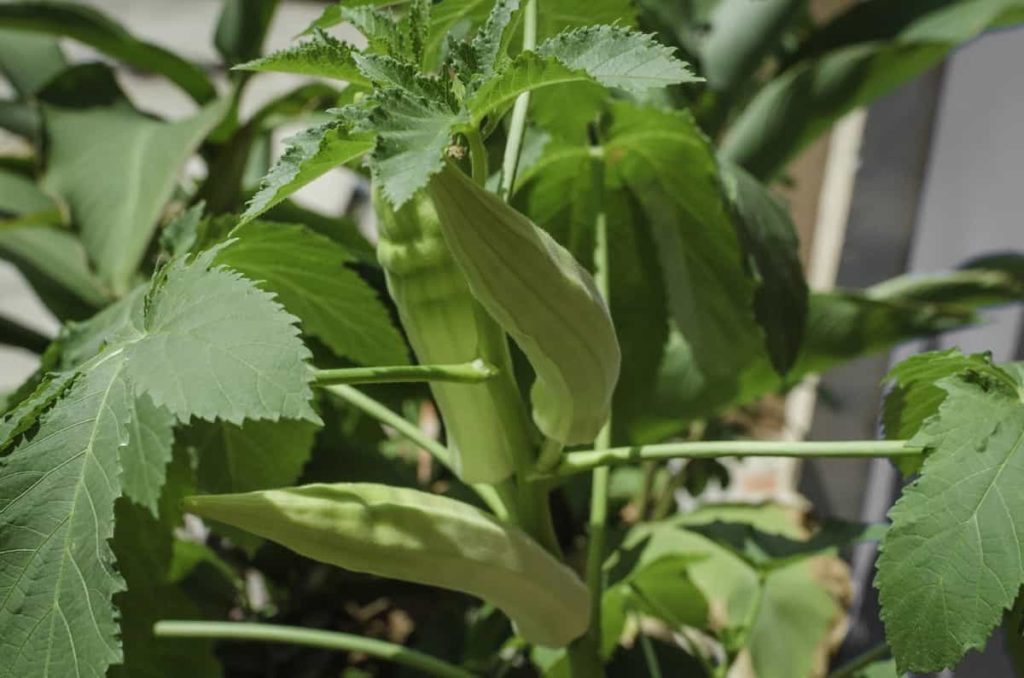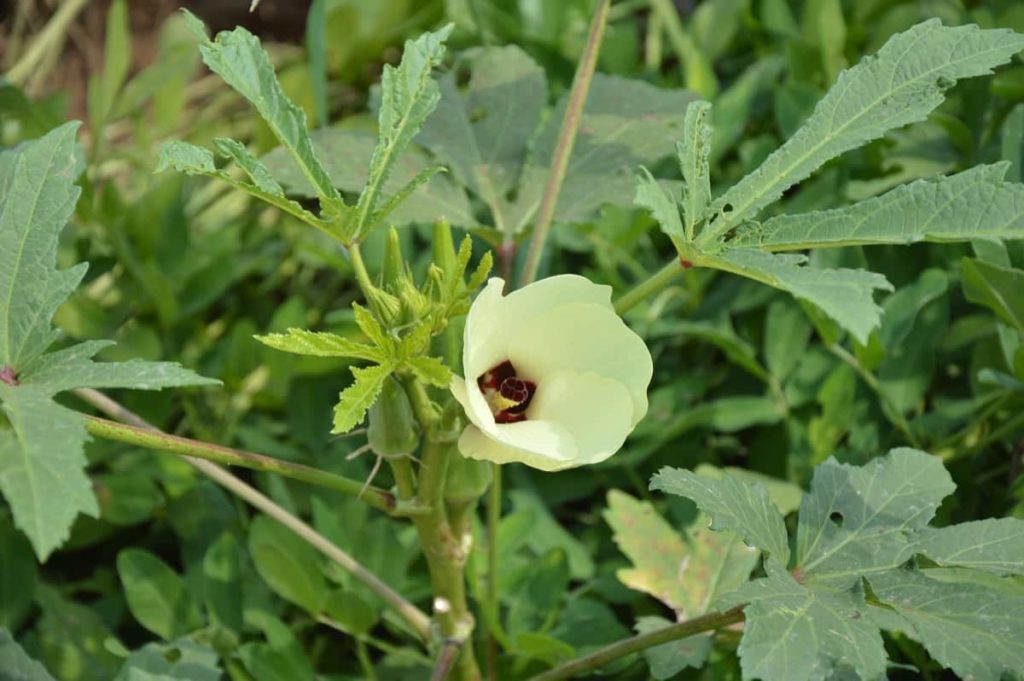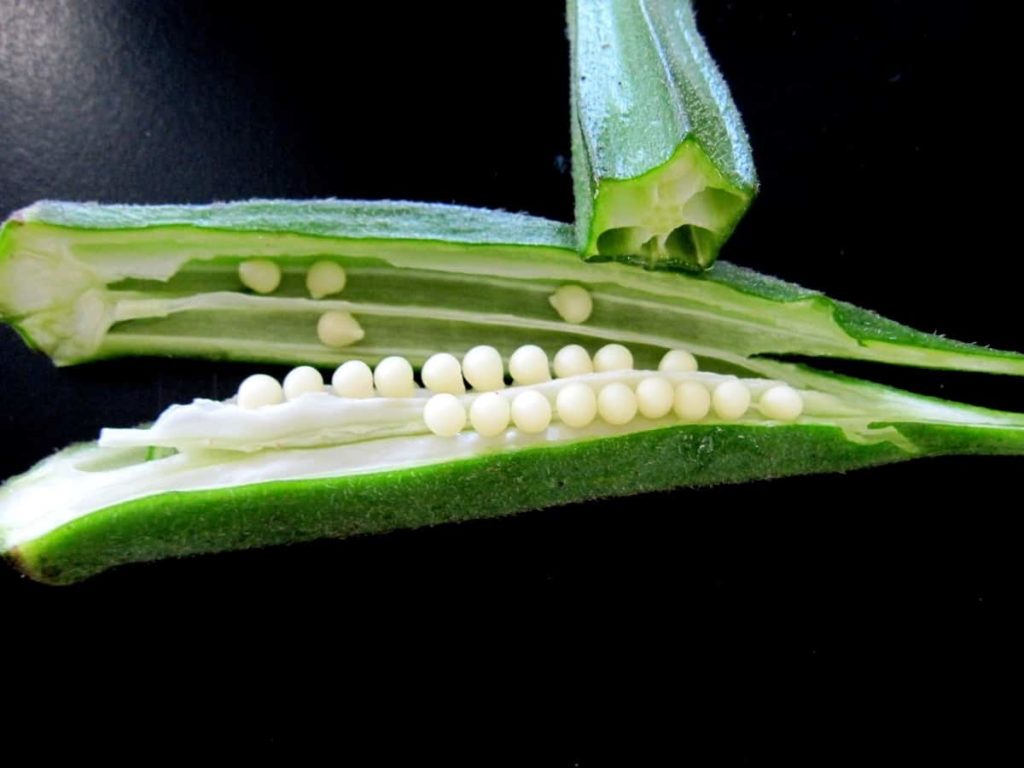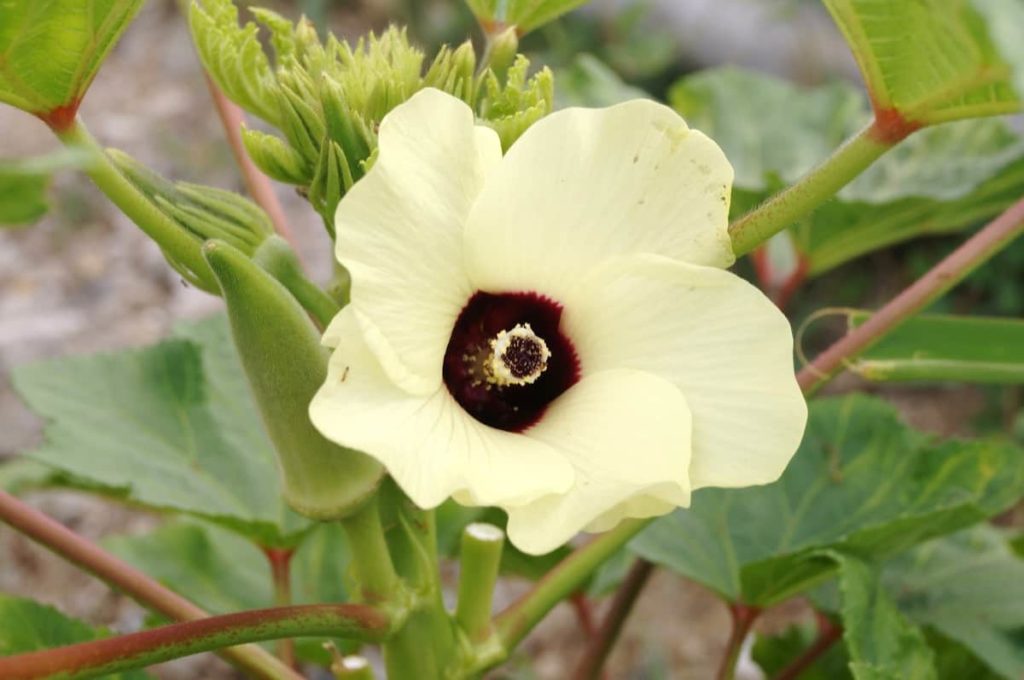Okra produces long edible pods on plants 3 to 6 feet long. It grows as an annual summer vegetable and does not tolerate frost. If you grow Okra in your garden, collecting Okra seeds is an inexpensive and easy way to get seeds for next year’s garden. Starting Okra plants from seed provides healthy plants that will grow into productive plants. The germination of Okra seed requires proper treatment and planting to sprout successfully. Okra plants produce pods throughout the summer, though in lessening quantities. Continuously harvest plants to maintain plant production. As a beginner, this article may help you to start your okra from seeds in your garden.

A Simple Guide to How to plant Okra from seeds
Preparing Okra seeds for planting
- You can establish Okra by sowing seeds directly in the garden. You should soak Okra seeds in water for several hours or overnight before sowing to increase germination. You should soak the Okra seeds in water for 12 to 18 hours before planting to soften their hard seed coat.
- Soaking helps in germination. Plant Okra in spring or early summer when the risk of cold is over. To prevent seeds from rotting, the soil should be heated to at least 19°C. Okra seed’s hard seed coat can hinder proper germination. As a result, seeds must be soaked before planting. To scarify the seeds, rub them with sandpaper.
How long does it take Okra to produce from seed?
- Okra seeds prefer full sunlight, average moisture without completely drying the soil if possible, and good soil drains well. For growing Okra, neutral soil is preferred.
- The plants take about two months to mature and should either be sown directly in the garden bed or started indoors. When starting seeds indoors, sow seeds in biodegradable pots 6 to 8 weeks before the date you want to transplant outside. You should start harvesting a few days after the Okra blooms fade.
The number of seeds needs to plant Okra
- Sow two seeds per pot and clip off the weak seedlings. While sowing the Okra directly into the ground, wait until after the soil warms and the air temperature reaches at least 19°C. You should soak seeds overnight or nick each seed coat with a file to encourage germination.
- Keep your Okra seeds about one and a half inches deep. Okra seeds are large, which makes them easier to sow. Keep two to three seeds per hole. You’ll plant one Okra plant per square foot in the garden. You can plant more than one Okra seed per hole to ensure a good stand and will go back and thin the extra Okra seedlings so that only one plant remains.
In case you missed it: How to Prepare Soil for Okra Plants: Best Soil Mix, pH, Compost, and Recipe

The best fertilizer for Okra
- The best fertilizer for Okra plants is compost tea. When used in the garden, plant once every two weeks after the transplant. You should water each transplant with a quarter of a gallon of compost tea, but make sure to soak the leaves a little as you do.
- After planting or mid-season pruning every six weeks, you can apply an additional 2/3 cup of fertilizer in a 25-foot row of Okra at least 3 inches away from the plants and mix it in the upper layer of soil. Water well after fertilizing.
- Okra should be pruned from 6 to 12 inches above the soil line. Once the plants are pruned, a fertilizer with a 1:2 ratio of nitrogen to potassium stimulates new growth and flower production. You can reapply the fertilizer every four to six weeks during the growing season (often when Okra is grown in pots). Irrigate the soil every time you apply fertilizer.
Water requirement for growing Okra
You can improve native soil by mixing aged compost or rich organic matter. Okra loves heat and can withstand dry spells, but do your best to water plants 1 inch per week. You should be well-watered throughout the summer months. You should give one inch of water per week, but you can use more if you are in a hot, arid region. High heat can decrease the growth of Okra. Prune the tops of Okra plants when they reach 5 to 6 feet tall.
What can you not plant near Okra?
- Most gardeners think of nematodes as beneficial for the garden. But they are harmful to Okra as these tiny pests like to feed the young roots of Okra plants. The presence of nematodes can be increased in soil used to grow some vine crops, such as Sweet Potatoes or Squash.
- Do not plant them too close, as cucumber vines spread and require large amounts of sun to ripen. Okra is very sensitive to nematodes, and nematode populations may increase at the end of the season. Avoid growing Squash, Sweet Potatoes, Tomatoes, Peppers, and Brinjal after Okra, as they may have been exposed to nematodes from the previous year.
How many Okra will one plant produce?
- In ideal conditions, Okra produces 20 to more than 30 pods per plant. Okra is a good choice for some autumn and winter vegetable gardens.
- However, harvesting Okra cannot be easy because you must harvest pods before it hardens. It only takes four days from the time the flowers arrive to pick up the Okra. Harvest Okra every other day so that they continue to produce for as long as possible.
Starting Okra seeds indoors
- When starting Okra seeds indoors, sow in peat pots. Plant 2 seeds in each pot. After germination, you should thin one plant per pot. You can sow Okra seeds indoors 6 to 8 weeks before the required outdoor planting date.
- Okra is usually started indoors in a greenhouse or hot, well-lit sunroom or kitchen. Sow Okra in individual pots of light potting mix for 6 to 4 weeks before you intend to set plants out. You can grow Okra transplants indoors in your home or purchase them from a local greenhouse.
In case you missed it: Okra Plant Growing Stages: Flowering, Fruiting in Pots/Containers at Home

Growing Okra in pots
- Ideally, a 5-gallon pot that is 10 to 12 inches deep and similar in diameter would be perfect for an Okra plant. It is better to choose a black pot as Okra loves the heat. To grow Okra in pots, start with a large pot with a diameter of at least 10 to 12 inches. A wide bottom pot is best because the plant can become top-heavy.
- Okra contains large taproots, so you need a pot they can contain. Okra roots can grow up to four feet deep under favorable conditions. Various sources claim that Okra takes the pH of soil below 5.8 and up to 7.5. But again, better conditions produce better output.
Should you trim Okra leaves?
- Once Okra leaves cannot produce food for the plant, the plant begins to get rid of them. Leaves tend to take up more energy than they produce, so cut off any small dying leaves bottom of the plant and any leaves that look weak or start to shrivel.
- Common Okra varieties grow in the summer, but the plant becomes too long to reach the top and does not produce many pods. When they are too tall to be harvested, cut your plants to a height between 12 and 24 inches.
- You should plan to remove the top of the Okra plant at least twice during the growing season. The best time to initially pinch Okra plants is when they are 24 inches tall. This allows the plant to be well established before pinching so that it has enough energy to devote to a new flush of growth.
- Re-cutting the top of Okra plants in late summer. Take off about one-third of the total height of the plant. It encourages new branches with the central stem and renews seed pod production.
Transplanting Okra seedlings
- You can grow Okra in many climates, but it grows best in warm weather. You can transplant Okra seedlings in late winter or early spring when the weather is still cool. If you transplant them during this time, they’ll be able to get a good start and grow bigger and stronger.
- Once the seedlings are 2 inches long, every 12 inches or more is thin in one plant, maintaining a healthy-looking plant. You should choose at least 18 inches wide and 12 inches deep containers if you want to grow Okra in a container.
How much space does Okra need?
You should soak Okra seeds in water for several hours or overnight before sowing to increase germination. The space rows are 3 feet apart. Sow seeds 1 inch deep and 4 to 6 inches apart within the row. When the seedlings are several inches long, thin the weak seedlings so that the rest of the plants are placed 1.5 to 2 feet apart.
In case you missed it: Best Fertilizer for Okra: Homemade, Liquid, Organic, Compost Manure, NPK, and Schedule

Why is my Okra growing so slow?
- Okra grows best at temperatures between 23°C to 32°C. When planting Okra, gardeners want to ensure that the soil temperature is warm enough for the seeds to germinate and grow, as cool soil can lead to slow growth and seedling diseases.
- Non-blooming Okra may suffer from dehydration. Okra tolerates more drought than many garden plants but watering it will keep it healthy and make it more productive. Okra plants need fertilizers that are higher in phosphorus than nitrogen. Water the plants well in the summer months. You should give more water if you’re in a warm, arid area.
Soil requirement for growing Okra
- Depending on the soil type, Okra production may vary, with loams and sandy loams preferred, but even heavier soils can produce well if the soil drains well enough to prevent water-logging. Okra will benefit from free-standing raised soil beds if the soil drainage is less than optimal. Although Okra grows best in soils with a pH between 6.5 and 7.0, it can grow in soils with a pH of up to 7.6. To increase the pH, add limestone to the top 7 inches of the soil, or to reduce it, work sulfur into the soil instead.
- You should prepare the soil properly for good growth. When you plow the soil, do it as deeply as possible, or at least 8 inches. You should work a 2-inch layer of compost into the soil to promote drainage and provide nutrients. Alternatively, add a traditional, slow-release fertilizer to the top 3 inches of the soil.
Sun requirement for growing Okra
- Okra requires full sunlight. Okra also has moderate nutritional requirements, so don’t go overboard on fertilizer.
- Okra thrives in the full sun. Regular watering is needed and is especially important during flowering and pod growth. During extended dry spells, weekly deep soaking is beneficial. Crop rotation and good soil management help in controlling diseases.
- Okra thrives in warm weather, so you can grow it as a shady plant for vegetables that work well in partial sunlight. It’s also a good idea to plant Okra and some early cool weather crops, such as Peas.
Germinating Okra seeds in a paper towel
Paper towels, filter paper, or even newspapers provide a suitable medium for germinating seeds. They are easy to control moisture content for proper seed germination. Drain the seeds on a sheet of paper towel for a few minutes before sowing but do not let them dry completely. Fill the peat pots with moist soil and slowly press the surface out of it. Sow two seeds in each pot at a depth of 1/2 inch.
In case you missed it: Okra Planting Frequently Asked Questions (FAQs)

Germinating Okra seed
- You should soak fresh seeds overnight or nick each seed coat with a file to encourage germination. Sow seeds 1/2 inch deep in light soil and 1 inch deep in heavy soil. The spacing in rows is at a distance of 3 feet apart and 3 inches apart. In addition to thin seedlings 18 to 24 inches, always choose the strongest of young plants.
- Sow the seeds in rows one inch deep, three feet apart. Seeds usually germinate in two to 12 days. You can grow Okra in many soil types, so add mulch and fertilizer. Once the plants begin to grow, thin them to be 12 to 18 inches apart.
The best month to plant Okra
Don’t sow seeds out or plant until all the risk of spring frost is gone. Okra can be planted indoors for four to six weeks between the last possible frost date. Okra seeds should be planted indoors and transplanted if you plan a spring harvest. However, for a summer and autumn Okra harvest, you can easily directly sow seeds because there is enough time to warm the soil. You can plant Okra in spring or early summer when the risk of cold is over.
How big should Okra be before picking?
- One of the critical points Okra enthusiasts will share with new Okra growers is when to harvest Okra. You should harvest Okra pods when they are 2 to 3 inches long. Larger than that, you’ll find pods are wooden and not as tender as they can be.
- Harvest Okra when seed pods are 1 to 2 days old and 2 to 4 inches long. They appear about two months after planting. This happens when Okra is at its softest and most digestible. The ripe Okra is about 2 to 3 inches long with vibrant color. Okra pods are either green or purple in color, depending on the variety. The Okra is ripe and ready for harvesting about five days after the plant’s flowering.
In case you missed it: Okra Growing Tips, Ideas, Secrets, and Techniques

Conclusion
So by this time, you would have learned about how to plant okra from seeds. You can grow Okra by planting seeds indoors and transplanting them when it is hot. Okra is an excellent option for gardeners in hot climates. They are surprisingly easy to grow and can produce enough to feed your family with just a few plants. An essential factor in starting your Okra seeds is timing. You can decide which Okra you want to grow by looking at a few different varieties and their characteristics.
- How to Grow Hibiscus from Flower
- Plantation Ideas for Home Decoration: A Beginners Guide
- Flower Garden Designs and Layouts for Beginners
- Planting and Spacing Techniques in Papaya: A Beginner’s Guide
- Growing Gold: Essential Techniques for Planting Pineapples
- How to Make Kalanchoe Plant Bushy: Home Remedies and Solutions
- 11 Reasons Why Your Gardenia is Not Blooming: Home Remedies and Solutions
- Eco Elegance: The Guide to Designing a Drought-Tolerant Landscape
- Gardening on a Slope: Strategies for Hillside Landscaping
- Nourish and Flourish: Top Organic Mulches for Thriving House Plants
- Everything You Want to Know about Indian Mogra Flower: Discover Uses and Growing
- Green Thumb Success: Expert Tips for Cultivating Greenhouse Pumpkins All Year Round
- Maximize Growth & Flavor: The Ultimate Guide to Companion Planting in Herb Gardens
- How to Control Rhododendron Problems Naturally: Home Remedies and Organic Ways to Fix Them
- Natural Magic: The Remarkable Benefits of Cinnamon for Plants
- Best Steps to Revive Dying Tulip with Natural and Organic Treatment
- 10 Reasons Why Your Angel Trumpet is Not Blooming: Remedies and Treatment
- How to Fix Periwinkle Leaf and Flower-Related Problems: Natural Remedies and Solutions
- How to Fix Zinnias Leaf and Flower Problems: Discover Natural and Home Remedies
- Organic Steps to Induce Lemon Tree Flowers: A Comprehensive Guide
- Bloom Booster: Crafting the Perfect Homemade Bougainvillea Fertilizer
- Optimizing Growth: A Guide to Applying NPK Fertilizer for Potted Plants
- 10 Best Homemade Fertilizers for Rubber Plant: DIY Recipes and Application Method
- How to Boost Female Pumpkin Flowers: Effective Steps for More Flowers and High Yields
- Transform Your Indoor Garden: Top Benefits of Pink Salt for Houseplants
- 10 Best Homemade Fertilizers for Peacock Plants (Calathea): Easy DIY Guide
- Unlock Blooms: 9 Reasons Why Your Potted Chrysanthemum is Not Blooming
- 8 Reasons Why Your Potted Hibiscus is Not Blooming: Fix it with Simple Solutions
- Unlock Blooms: 9 Key Reasons Your Potted Frangipani Won’t Flower
- 10 Reasons Why Is My Ice Plant Not Blooming: Remedies and Treatment
- 10 Reasons Why My Potted Hydrangea Not Blooming: Treatment and Remedies
- 10 Reasons Why is My Wisteria Not Blooming: Remedies and Treatment
- 10 Reasons Why is My Goldfish Plant Not Blooming: Remedies and Treatment
- Maximize Your Space: Ultimate Guide to Balcony Gardening with Grow Bags
- 10 Reasons Why Your Iris is Not Blooming: Remedies and Treatment
- 10 Reasons Why Your Anthurium Plant is Not Blooming: Treatment and Remedies